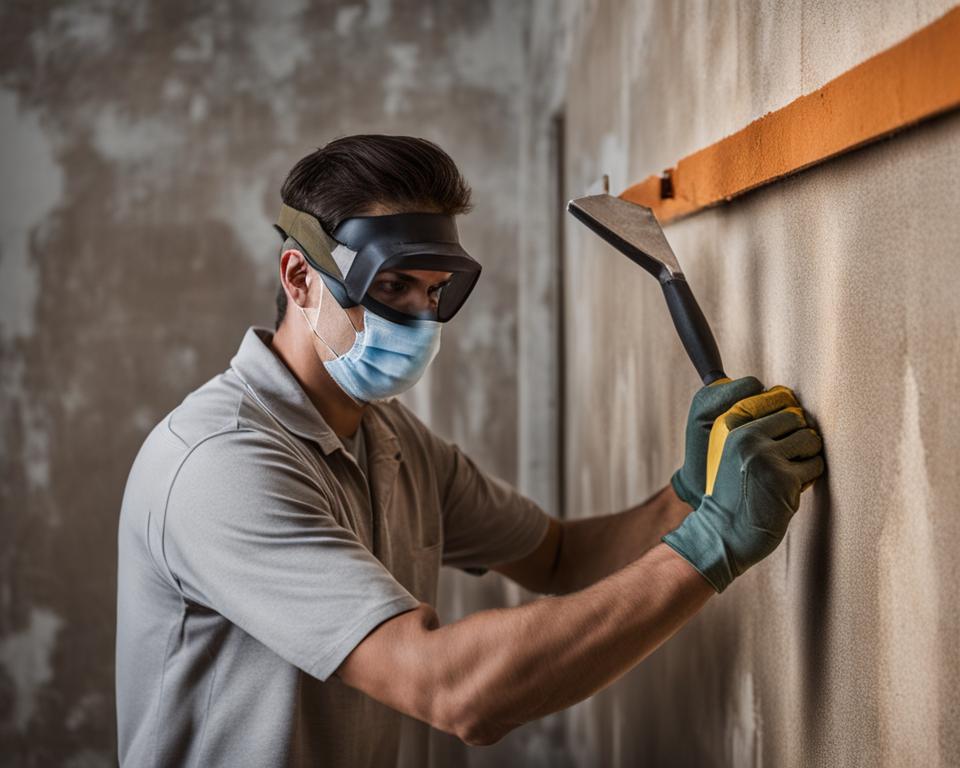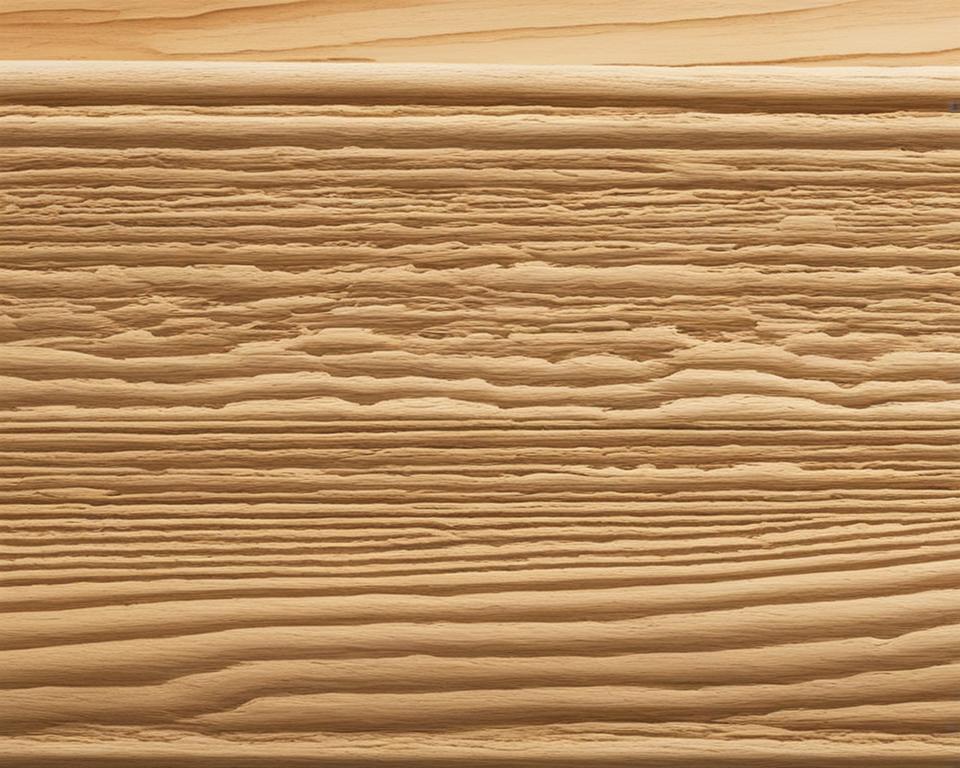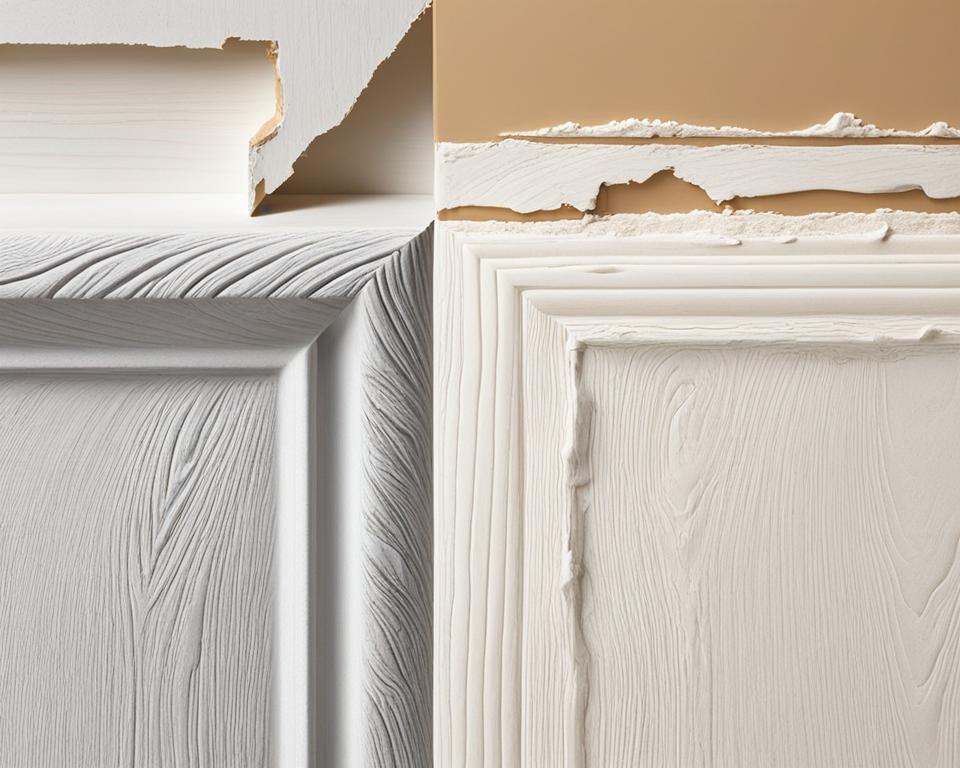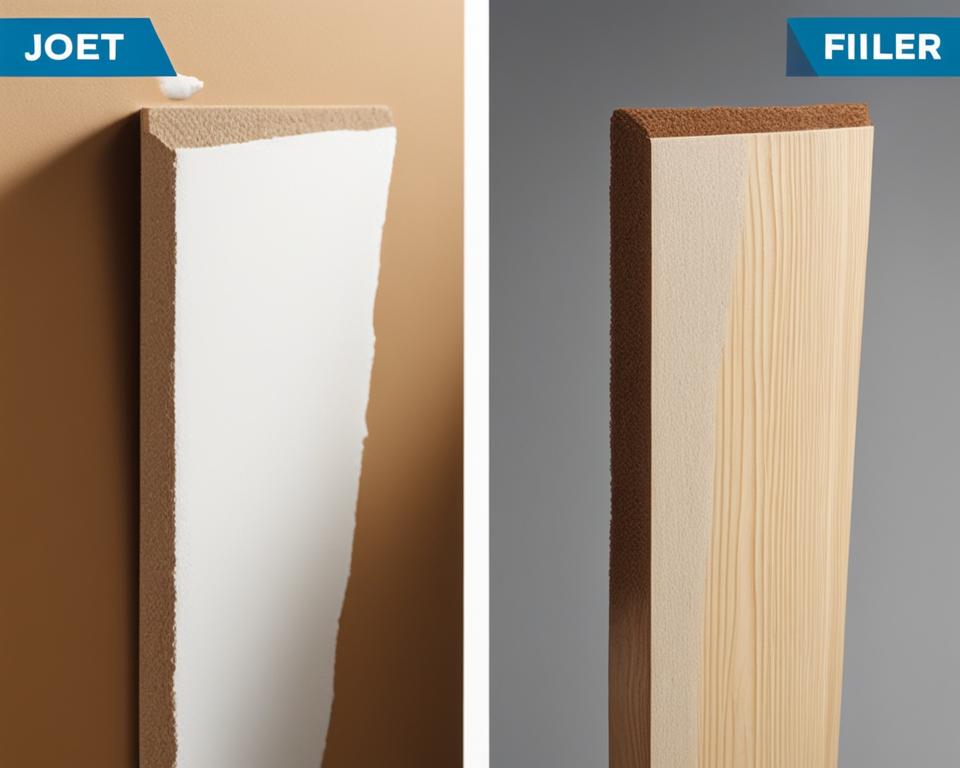When it comes to filling holes and gaps in DIY projects, two popular options are joint compound and wood filler. Understanding the differences between these materials and knowing when to use each one is crucial for achieving professional results. In this article, we’ll explore the properties, uses, and benefits of joint compound and wood filler, comparing them side by side to help you make an informed choice for your specific project needs.
Key Takeaways:
- Joint compound and wood filler are commonly used for filling holes and gaps in DIY projects.
- Joint compound is ideal for drywall installations and creating smooth wall surfaces.
- Wood filler is specifically designed for repairing wooden surfaces and achieving a seamless finish in woodworking projects.
- Consider the material you are working with and the desired finish when choosing between joint compound and wood filler.
- Choosing the right product and following proper application techniques will help you achieve professional results.
What is Joint Compound?
Joint compound, also known as drywall mud, is a versatile material used in the construction and renovation of walls. It is a gypsum-based product that comes in paste form and is applied to drywall surfaces to create a smooth and seamless finish.
Joint compound is commonly used for filling in holes, cracks, and gaps in drywall, achieving a flat and even surface. It is also an essential component for taping and finishing drywall seams. Joint compound can be sanded to achieve a smooth finish, making it a popular choice for wall repairs and preparation before painting.

What is Wood Filler?
Wood filler, also known as wood putty, is a substance specifically designed for filling holes, cracks, and imperfections in wooden surfaces. It is made of a combination of wood fibers or sawdust and a binder material, such as epoxy or cellulose. Wood filler is commonly used in woodworking projects, such as furniture making, cabinetry, and carpentry, to repair damaged wood and achieve a smooth and seamless finish.
Wood filler offers a practical solution for addressing various issues in wooden surfaces. Whether you need to repair a cracked tabletop or fill nail holes in a cabinet door, wood filler is the go-to product. It allows you to restore the appearance and structural integrity of the wood, ensuring a professional finish.

One of the key advantages of wood filler is its versatility. It is available in different colors to match the natural tones of various wood types, making it easy to blend seamlessly with your project. After applying wood filler, you can sand, stain, or paint over it to achieve a cohesive look.
Although wood filler is durable and stable once dry, it is not as easily sanded as joint compound. However, with careful application and sanding techniques, you can achieve a smooth surface that prepares your wooden project for the final finish.
Benefits of Wood Filler
Wood filler provides several benefits for woodworking projects and repairing wooden furniture:
- Seamless repairs: Wood filler seamlessly fills in holes, cracks, and imperfections, allowing you to achieve a flawless finish.
- Enhances durability: The added stability and strength provided by wood filler contribute to the longevity of wooden surfaces.
- Easy customization: Wood filler comes in various colors, providing flexibility to match different wood tones and finishes.
- Multiple applications: Wood filler can be used in a wide range of projects, including furniture making, cabinetry, and carpentry.
Wood Filler Application Tips
When using wood filler, here are a few tips to keep in mind:
“Apply the wood filler generously to ensure proper coverage of the damaged area. Use a putty knife or a flexible applicator tool to spread the filler evenly.”
1. Clean the surface: Ensure the wooden surface is clean and free of dust or debris before applying the wood filler.
2. Choose the right filler: Select a wood filler that matches the color and type of wood you are working with for a seamless repair.
3. Apply and shape: Use a putty knife or a flexible applicator tool to apply the wood filler to the damaged area. Fill the hole or crack generously and shape the filler to match the surrounding surface.
4. Allow drying time: Follow the manufacturer’s instructions for drying time. Typically, wood fillers require several hours to dry completely.
5. Sand and finish: After the wood filler has dried, use sandpaper to smooth the repaired area. Remove any excess filler and sand until the surface is level and smooth. Finally, apply the desired finish, such as stain or paint, to match the surrounding wood.
| Advantages of Wood Filler | Disadvantages of Wood Filler |
|---|---|
| Seamless repairs | Not as easily sanded as joint compound |
| Enhances durability | |
| Easy customization | |
| Multiple applications |
Differences Between Joint Compound and Wood Filler
Joint compound and wood filler have distinct properties and uses, making them suitable for different purposes.
Joint compound is a gypsum-based product that provides a solid surface with its high density. It is commonly used for achieving smooth and flat finishes on walls, particularly in drywall installations. Joint compound can be easily sanded and layered to fill larger holes and gaps in drywall.
On the other hand, wood filler is made from a combination of wood fibers or sawdust and a binder material, giving it a less dense and more porous consistency. It is specifically designed for filling holes and imperfections in wooden surfaces. Wood filler provides a stable repair and can be stained or painted over, making it ideal for achieving a seamless finish in woodworking projects.

When deciding between joint compound and wood filler, it’s important to consider the specific requirements of your project. If you are working with drywall or need to fill holes and gaps in drywall, joint compound is the best choice. However, if you are working with wood or need to repair wooden surfaces, wood filler is the more suitable option.
Uses of Joint Compound and Wood Filler
Joint compound and wood filler are versatile materials that serve specific purposes in DIY projects. Understanding their applications is essential for achieving professional results. Let’s explore the uses of joint compound and wood filler in different contexts.
Applications of Joint Compound
Joint compound is primarily used for filling holes, cracks, and gaps in drywall installations. Here are its key applications:
- Filling holes and gaps in drywall: Joint compound provides a smooth and even surface, ensuring a seamless finish.
- Taping and finishing drywall seams: It is crucial for achieving strong and invisible joints between drywall panels.
- Preparing walls for painting or wallpapering: Joint compound creates a flat and uniform surface, enhancing the final aesthetic.
However, it’s important to note that joint compound is not suitable for repairing wooden surfaces or filling holes in wooden furniture.
Applications of Wood Filler
Wood filler is specifically designed for filling holes and imperfections in wooden surfaces. Its versatile applications include:
- Woodworking projects: Wood filler is an essential tool for achieving a seamless and professional finish in furniture making, cabinetry, and carpentry.
- Repairing damaged wooden furniture: It effectively fills in cracks and holes, restoring the integrity and aesthetics of wooden pieces.
- Filling nail holes: Wood filler ensures a flawless surface by concealing visible nail holes in woodworking projects.
- Smoothing joints: It assists in creating smooth transitions where two pieces of wood come together, ensuring a refined result.
Wood filler is specifically formulated for wooden surfaces and is not suitable for use on drywall.
By understanding the distinct uses of joint compound and wood filler, you can choose the right material for your specific project, whether it’s a drywall installation or a woodworking endeavor.
When to Use Joint Compound or Wood Filler
The choice between joint compound and wood filler depends on the specific requirements of your project. Each product has its own strengths and best uses, so it’s important to consider their properties and applications before making a decision.
If you are working on a drywall installation or need to fill holes and gaps in drywall, joint compound is the ideal choice. Joint compound, also known as drywall mud, is specifically designed for drywall repairs and creating smooth surfaces. It provides a solid and durable surface that can be sanded to achieve a seamless finish. Whether you’re patching up small holes or covering larger gaps, joint compound is versatile and can be applied in multiple layers to achieve the desired result. It is also suitable for painting or wallpapering over once dry, allowing for further customization of your walls.
On the other hand, if you are working on a woodworking project or need to repair wooden surfaces, wood filler is the better option. Wood filler is specifically formulated to fill holes, cracks, and imperfections in wooden surfaces. It is available in different colors to match various wood tones and can be stained or painted over once dry, providing a seamless and professional finish. Whether you’re working on furniture repairs, cabinetry, or other woodworking endeavors, wood filler is your go-to product for achieving a stable and long-lasting repair. However, it’s important to note that wood filler is not as easily sanded as joint compound, so it’s crucial to apply it accurately and finish it to your desired level before it dries.
Consider the material you are working with and the desired finish when choosing between joint compound and wood filler. Understanding their differences and best uses will enable you to make an informed decision and achieve professional results in your DIY projects. Whether you’re working on drywall or woodworking, joint compound and wood filler are reliable materials that will help you achieve a polished and finished look.
Conclusion
Joint compound and wood filler are two essential materials for achieving professional results in your DIY projects. Understanding their differences and best uses is crucial for choosing the right product and achieving the desired finish. Joint compound, primarily used for drywall installations, is perfect for filling holes and gaps in walls, creating smooth and flat surfaces. On the other hand, wood filler is specifically designed for repairing wooden surfaces in woodworking projects, providing a seamless and professional finish.
When deciding between joint compound and wood filler, consider the specific requirements of your project and the material you are working with. If you are working on a drywall installation or need to fill gaps in walls, joint compound is the ideal choice. However, if you are working on a woodworking project or need to repair damaged wooden surfaces, wood filler is the better option.
By selecting the correct product and following proper application techniques, you can achieve professional results in your home repairs or woodworking endeavors. Whether you are filling holes in drywall or repairing wooden furniture, joint compound and wood filler will help you achieve the desired outcome and create a seamless finish that enhances the overall aesthetic of your project.
FAQ
What is joint compound?
Joint compound, also known as drywall mud, is a versatile material used in the construction and renovation of walls. It is a gypsum-based product that comes in paste form and is applied to drywall surfaces to create a smooth and seamless finish. Joint compound is commonly used for filling in holes, cracks, and gaps in drywall, achieving a flat and even surface.
What is wood filler?
Wood filler, also known as wood putty, is a substance specifically designed for filling holes, cracks, and imperfections in wooden surfaces. It is made of a combination of wood fibers or sawdust and a binder material, such as epoxy or cellulose. Wood filler is commonly used in woodworking projects, such as furniture making, cabinetry, and carpentry, to repair damaged wood and achieve a smooth and seamless finish.
What are the differences between joint compound and wood filler?
Joint compound is a gypsum-based product that provides a solid surface when applied, while wood filler has a less dense and more porous consistency due to its combination of wood fibers and binder material. Additionally, joint compound is primarily used for filling holes, cracks, and gaps in drywall, while wood filler is specifically designed for filling holes and imperfections in wooden surfaces.
What are the uses of joint compound and wood filler?
Joint compound is primarily used for filling holes, cracks, and gaps in drywall installations, as well as for taping and finishing drywall seams. Wood filler, on the other hand, is commonly used in woodworking projects, such as furniture making and cabinetry, to fill holes and imperfections in wooden surfaces. It can also be used for repairing damaged wooden furniture and smoothing joints where two pieces of wood come together.
When should I use joint compound or wood filler?
The choice between joint compound and wood filler depends on the specific requirements of your project. If you are working on a drywall installation or need to fill holes and gaps in drywall, joint compound is the ideal choice. On the other hand, if you are working on a woodworking project or need to repair wooden surfaces, wood filler is the better option.
How can I achieve professional results with joint compound and wood filler?
To achieve professional results with joint compound and wood filler, it is important to choose the right product based on your project’s specific requirements. Follow proper application techniques and ensure that the product is applied evenly and smoothly. Sand the dried compound or filler as needed to achieve a seamless and smooth finish. Lastly, consider staining or painting over the repaired areas to match the surrounding surface.
